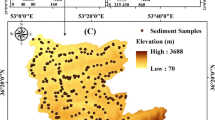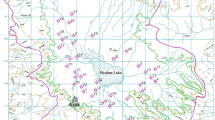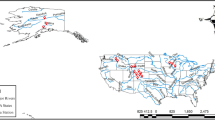Arsenic is often present in gold mining areas. The high sensitivity of arsenic to biogeochemical conditions may lead to catastrophic consequences through contamination of resources such as ground water. Therefore, it is critical to understand the spatial occurrence of arsenic across a given site. Previous studies using traditional pattern recognition techniques such as neural networks and kriging have not been entirely successful in predicting arsenic concentrations across a gold mining area. The methods used in this paper are the support vector machines (SVM) and robust least-square support vector machines (robust LS-SVM). The two techniques were used to predict arsenic concentrations in the sediments of Circle City, Alaska, using the gold concentration distribution present within the sediments. The analysis of the results shows an improved performance and better predictive capabilities of SVM and robust LS-SVM than that of the neural networks and kriging techniques. The robust LS-SVM performed better than the SVM. The performance of the SVM was affected by outliers. The removal of the outliers from the data set and application of SVM showed improved results.











Similar content being viewed by others
REFERENCES
Andreae, M. O., 1980, Arsenic in rain and the atmospheric mass balance of arsenic: J. Geophys. Res., v. 85, no. 8, p. 4512–4518.
Axtmann, E. V., and Luoma, S. N., 1991, Large-scale distribution of metal contamination in the fine-grained sediments of the Clark Fork River, Montana, U.S.A: Appl.Geochem., v. 6, p. 75–88.
Azcue, J. M., and Nriagu, J. O., 1994, Arsenic: Historical perspectives, in Nriagu J. O., ed., Advances in Environmental Science and Technology: Arsenic in the Environment. Part 1: Cycling and Characterization, Wiley, NY, p. 1–16.
De Brabanter, J., 2004, LS-SVM Regression Modelling and its Applications (2004): PhD dissertation, Katholieke universiteit, Kasteelpark Arenberg 10, 3001 Leuven (Heverlee), 245 p.
Fan, R. E., Chen, P.-H., and Lin, C.-J., 2005, Working set selection using the second order information for training SVM. Journal of Machine Learning Research, v. 6, no. 12, p. 1889–1918.
Focazio, M. J., Welch, A. H., Watkins, S. A., Helsel, D. R., and Horn, M. A., 1999, A retrospective analysis on the occurrence of arsenic in ground-water resources of the United States and limitations in drinking water supply characterizations: U.S. Geological Survey, Water Resources Investigation Report 99-4279, 21 p.
Metz, P. A., 1991, Metallogeny of the Fairbanks Mining District, Alaska and Adjacent Areas: MIRL Report No. 90, 370 p.
Misra, D., Samanta, B., Dutta, S., and Bandopadhyay, S., 2005, Evaluation of artificial neural network and kriging for the prediction of arsenic in bedrock derived stream sediments using gold concentration data: Int. J. Surface Min. Reclam. Environ., accepted.
Moore, J. N., 1994, Contaminant mobilization resulting from redox pumping in a metal-contaminated river-reservoir system, in Environmental Chemistry of Lakes and Reservoirs, Washington, DC: American Chemical Society, p. 451–471.
Mukherjee, S., Osuna, E., and Girosi, F., 1997, Nonlinear prediction of chaotic time series using a support vector machine: in Principe, J., Gile, L., Morgan, N., and Wilson, E., eds., Proceedings of the VII 1997 IEEE Workshop on Neural Networks for Signal Processing, IEEE, p. 5–11.
Nimick, D. A., 1994, Arsenic transport in surface and ground water in the Madison and Upper Missouri River Valleys: Montana: EOS, v. 75, no. 1, p. 247.
Nimick, D. A., Moore, J. N., Dalby, C. E., and Savka, M. W., 1998, The fate of arsenic in the Madison and Missouri Rivers, Montana and Wyoming: Water Resources Res., v. 34, no. 11, p. 3051–3067.
NRC, 1999, Arsenic in Drinking Water: National Academy Press, Washington, DC, 330 p.
NRC, 2001, Arsenic in Drinking Water: Update 2001: National Academy Press, Washington, DC, 244 p.
Pannatier, Y., 1996, VARIOWIN: Software for Spatial Data Analysis in 2D: Springer-Verlag, New York, NY, 25 p.
Savenije, H. H. G., 2001, Equifinality, a blessing in disguise? Hydrol. Process., v. 15, no. 14, p. 2835–2838.
Samanta, B., Bandopadhyay, S., and Ganguli, R., 2002, Data segmentation and genetic algorithms for sparse data division in Nome Placer gold grade estimation using neural network and geostatistics: Explor. Min. Geol. v. 11, no. 1–4; p. 69–76; DOI: 10.2113/11.1-4.69.
Schölkopf, B., Smola, A., Williamson, R., and Bartlett, P. L., 2000, New support vector algorithms: Neural Comput., v. 12, p. 1207–1245.
Suykens, J. A. K., Gestel, T. V., De Brabanter, J., De Moor, B., and Vandewalle, J., 2002, Least Squares Support Vector Machines: World Scientific, Singapore, 308 p.
Vapnik, V., 1995, The Nature of Statistical Learning Theory: Springer, New York, 314 p.
Vapnik, V., 1998, Statistical Learning Theory: Wiley, New York, 736 p.
Welch, A. H., Westjohn, D. B., Helsel, D. R., and Wanty, R. B., 2000, Arsenic in ground water of the United States: Occurrence and geochemistry: Ground Water, v. 38, no. 4, p. 589–604.
Wiltse, M. A., 1987, Geochemistry of the Lime Peak-Mt. Prindle area west-central Circle Quadrangle, Alaska, in Smith, T. E., Pessel, G. H., and Wiltse, M. A., eds., Mineral Assessment of the Lime Peak-Mt. Prindle area, Alaska: Alaska Division of Geological and Geophysical Surveys Miscellaneous Publication 29E, p. 6.1–6.37.
Author information
Authors and Affiliations
Corresponding author
Rights and permissions
About this article
Cite this article
Twarakavi, N.K.C., Misra, D. & Bandopadhyay, S. Prediction of Arsenic in Bedrock Derived Stream Sediments at a Gold Mine Site Under Conditions of Sparse Data. Nat Resour Res 15, 15–26 (2006). https://doi.org/10.1007/s11053-006-9013-6
Published:
Issue Date:
DOI: https://doi.org/10.1007/s11053-006-9013-6




